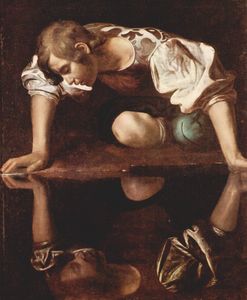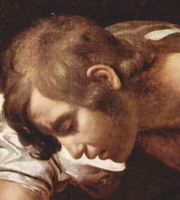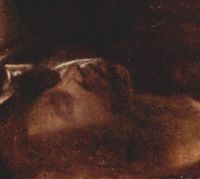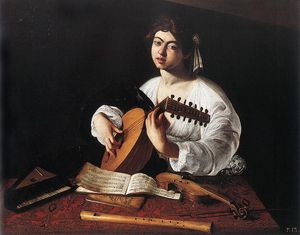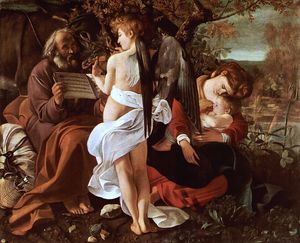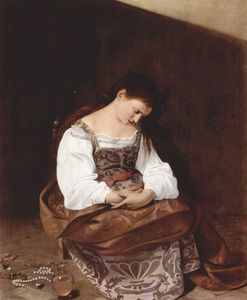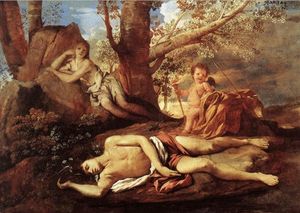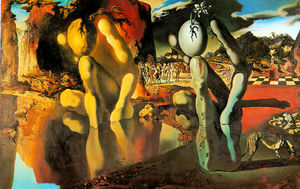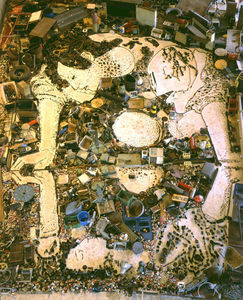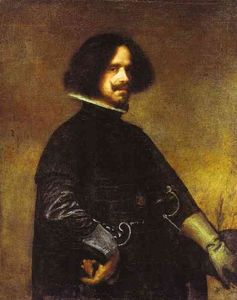Narcissus
- Date of Creation:
- 1599
- Height (cm):
- 110.00
- Length (cm):
- 92.00
- Medium:
- Oil
- Support:
- Canvas
- Subject:
- Fantasy
- Art Movement:
- Baroque
- Created by:
- Current Location:
- Rome, Italy
- Displayed at:
- Galleria Borghese
- Owner:
- Galleria Borghese
- Narcissus Page's Content
- Story / Theme
- Inspirations for the Work
- Analysis
- Related Paintings
- Artist
- Art Period
- Bibliography
Narcissus Story / Theme
The story of Narcissus comes from Greco-Roman mythology. The most popular version is from Ovid's Metamorphosis 3.5, from which Caravaggio's interpretation is taken. Legend has it that Narcissus was the preternaturally beautiful son of the nymph Leiriope and the river god Cephissus.
When Narcissus was still a young boy, his mother took him to the blind prophet, Tiresias, to have his fortune told. The blind prophet predicted that "If he but fails to recognize himself, a long life he may have, beneath the sun."
Unfortunately for Narcissus, he was to recognize himself all too soon. A vain and snobbish youth, he refused the fervent amorous advances of a multitude of young ladies, but was to finally meet a worthy match when he came across his own reflection in a pool. The boy fell madly and irrevocably in love with himself;
"And how he kisses the deceitful fount;
and how he thrusts his arms to catch the neck
that's pictured in the middle of the stream!"
Narcissus stayed beside the stream gazing at his reflected paramour in vain, neglecting even to eat or drink. Upon his death, his body was transformed into a beautiful yellow flower, which still carries his name today.
All circumstances surrounding the attribution, commission and execution of this work are completely unknown. In fact, the Narcissus has only recently been accepted as a Caravaggio.
Analysis of the stylistic bases of this work, comparison to other works of Caravaggio and the painting's iconographic innovativeness mean this it is accepted as a work of Caravaggio but some scholars remain doubtful. The only concrete evidence is an export license from 1645, which lists a Narcissus by Caravaggio with similar dimensions to this version.
Narcissus Inspirations for the Work
This work was produced during the middle of Caravaggio's career, a time that is not fully understood. During this time, however, Caravaggio preferred a magical sense of atmosphere, suspense, and introspection.
The influence of the Lombard style of Moretto and Savoldo were still profound and Caravaggio's experiments with light and shadow were evident.
Like his Lute Player, Caravaggio's Narcissus, is perhaps also a vanitas, a warning against the darkness that can result from the vain pleasures of love and youth. It's likely that this work is linked to Roman literary circles, dominated by Marino, and was perhaps painted with the support of Marino and Vincenzo Giustiniani.
Narcissus Analysis
Given the lack of p&agravzzz;per proof, art historians draw on stylistic evidence to try to determine if this Narcissus is, indeed, an original Caravaggio. Though, above and beyond technical and stylistic analyses, the painting has a magnetism and eerie beauty unique to Caravaggio's oeuvre.
Most scholars thus accept the Narcissus as an original Caravaggio, and date it in the last years of the 16th century, a transitional period in the artist's career.
The following points make a case for the attribution of this painting to Caravaggio;
Use of technique:
Chiaroscuro: The Narcissus evidences the same interest in dramatic contrast between inky darks and brilliant, golden light that illuminates the rest of Caravaggio's oeuvre.
Composition:
Caravaggio's early works are almost always set in a neutral, undefined space. The artist is also known for re-using the same models in his paintings. The boy shown here bears a remarkable resemblance to the angel in Rest on the Flight into Egypt.
Narcissus is wearing a vest made of the same material as Mary Magdalene's dress in Caravaggio's The Penitent Magdalene. Especially while still a poor young artist, Caravaggio was known to reuse the same models and costumes in order to save money.
Mood:
Caravaggio conveys a dark melancholy. Narcissus' eyes are deeply shadowed, his full lips voluptuous, and his yearning gaze is fixed on black water. This water was frequently associated by ancient writers with the waters of the Styx, and the narcissus into which the boy was transformed was associated with death, with Demeter and Persephone, with dank pools and funereal flowers.
Narcissus Related Paintings
Narcissus Artist
The story of Narcissus was well known among collectors, such as Cardinal Francesco Maria Del Monte and the banker Vincenzo Giustiniani who were fans of Caravaggio's work. The story of Narcissus was also appealing to artists.
Caravaggio was as controversial for his revolutionary artworks as he was for his infamous temper and lengthy police record. He ignored the rules that artists from the previous century had followed and instead developed a love of realism and his emotional directness was unrivalled.
Caravaggio's paintings constitute some of the most stunning works in the entire history of Western art. Observing the evolution of his style from his early works to his last paintings is a chronicle of his life.
Caravaggio played a key role in defining 17th century Italian art. In the 20th century when emerging artists were adopting his techniques and imitating his style. Caravaggism had profound effects on the art world and artists that were directly and indirectly influenced by Caravaggio include Rubens, Hals, Rembrandt, Vermeer, Velazquez and Bernini.
Narcissus Art Period
The Baroque style originated in Italy and its pioneers include great artists such as Michelangelo and Tintoretto. Baroque art focused on impersonal and generic works with an animated and energetic mood. The success of this art genre was promoted by the Roman Catholic Church and the aristocracy, the latter of which saw Baroque art as a means of demonstrating wealth and power.
Caravaggio is a pioneer of the Italian Baroque style that grew out of the ruins of Mannerism. At the end of the 16th century, the artist was exposed both to the artistic reforms of the Counter-Reformation as well as to a new interest in scientific naturalism flourishing in northern Italy, due in part to the influx of artworks from northern Europe.
Out of this context, Caravaggio developed a style of unflinching realism, unprecedented approachability and a direct appeal to the emotions that had no equal among his peers and helped to mould 17th century Italian art.
Italian Baroque art was not widely different to Italian Renaissance painting but the color palette was richer and darker and the theme of religion was more popular. There remains some mystery surrounding the true derivation of Italian Baroque but some argue that the word 'Baroque' comes from the Italian "Barocco".
Caravaggio's influence is evident both directly or indirectly in the paintings artist such as of Rubens, Bernini, Jusepe de Ribera and Rembrandt, and the next generation of artists profoundly influence by Caravaggio were labeled the "Caravaggisti" or "Caravagesques", as well as Tenebrists or "Tenebrosi" ("shadowists").
Bernard Berenson agreed: "With the exception of Michelangelo, no other Italian painter exercised so great an influence".
Narcissus Bibliography
To read more about Caravaggio and his works please refer to the recommended reading list below.
• Bernedetti, Sergio. Caravaggio: The master revealed. Dublin: The National Gallery of Ireland, 1993
• Freedberg, S. J. Circa 1600:A revolution in the style of Italian painting. Cambridge, Mass. : Harvard University Press, 1983
• Friedlander, Walter. Caravaggio Studies. New York: Schocken Books, 1969
• Gilbert, Creighton. Caravaggio: his two Cardinals. University Park: Pennsylvania State University Press, 1995
• Hibbard, Howard. Caravaggio. New York: Harper and Row, 1983
• Hinks, R. P. Michelangelo Merisi da Caravaggio: His life, his legend, his works. London: Faber & Faber, 1953
• Langdon, Helen. Caravaggio: A life. New York: Farrar, Straus & Giroux, 1999
• Mancini, Giulio, Giovanni Baglione, and Giovanni Bellori. Lives of Caravaggio. London: Pallas Athene, 2005
• Moir, Alfred. Caravaggio. New York: H. N. Abrams, 1989
• Varriano, John. Caravaggio: the art of realism. University Park: Pennsylvania State University Press, 2006

